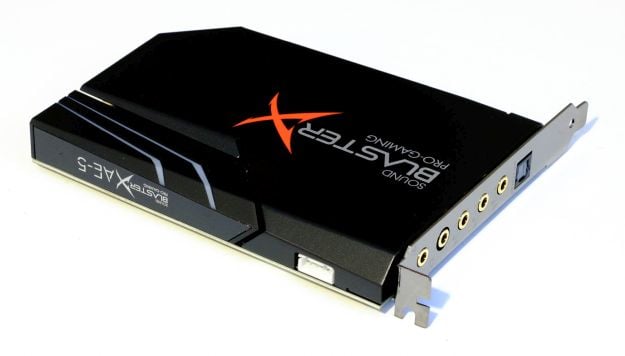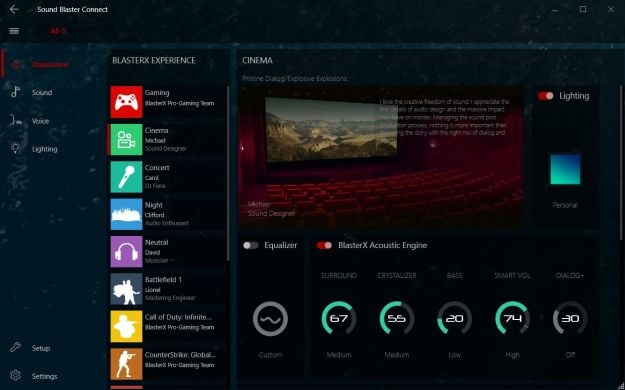Sound BlasterX AE-5 Review: An Uncompromising Gaming Sound Card For Audiophiles
Creative Labs kept the Sound BlasterX AE-5 looks subdued. There’s a black cover that hides all the components with the appropriate Sound BlasterX Pro-Gaming logos and white stripes for RGB lighting. Aside from the cover, there isn’t much you can do to make a PCI Express x1 sound card look too exciting. There’s a Sound BlasterX AE-5 Pure Edition that sports a white cover coming later as well.
The Sound BlasterX AE-5 supports up to 5.1-channel analog audio output for speakers, with a dedicated Xamp headphone output. There’s a combination analog line-in and microphone jack for recording, and optical S/PDIF output, too. A standard HD audio header is available internally so you can use your case’s audio jacks with the Xamp.
A header on the top of the card enables compatibility with most 4-pin RGB lighting strips. The placement of the RGB header is in an annoying location that makes it harder to have clean wire management, however. It sticks straight out of the top where you can see it with any windowed case. The ideal placement for the connector should’ve been on the bottom of the card closer to the PCIe connector so you can hide the wiring easier.
Creative Labs includes a single 10 LED lighting strip and extension cable with the standard Sound BlasterX AE-5, but the upcoming Pure Edition includes four. The Sound BlasterX AE-5 requires power from a MOLEX connector to use the Aurora Reactive RGB controller, however, the integrated RGB Sound BlasterX AE-5 logo functions without additional power. The reason Creative Labs went with MOLEX instead of the SATA power connector is due to amperage.
SATA only delivers up to 1.5-amps at 5-volts (7.5-watts) whereas MOLEX supplies up to 11-amps (55-watts). Each 10-LED light strip requires 3-4.5-watts and being able to run four strips requires up to 18-watts – over double what the SATA power connector can provide. The MOLEX connector isn’t as slim the SATA connector, but you can easily hide it with black connectors and cables.
SB Connect is the control center for all the Sound BlasterX AE-5 functions. The dashboard presents a variety of audio presets that include generic gaming, cinema, concert and neutral presets tuned by sound designers, DJ’s, audio enthusiasts and musicians. There’s even game and game-type specific audio profiles for CounterStrike: Global Offensive, DOT 2, Overwatch, Call of Duty and more, tuned by the BlasterX Pro-Gaming Team. The audio profiles include equalizer, BlasterX Acoustic Engine, voice and lighting settings. You can always forgo the presets and save your own, too.
A 10-band EQ lets you adjust frequencies from 31Hz to 16kHz, or you can adjust a bass and treble slider if you only want a little bump in the thump and clarity department. The typical EQ music presets for music genres is present, like hip-hop, rock, pop, jazz and others. There’s a simpler Acoustic Engine setting that has dials to crank up the surround and crystalizer effects, bump the bass, smart volume and enhance dialogue for simpler controls.
Creative Labs includes comprehensive voice adjustments for microphones plugged into the Sound BlasterX AE-5. There’s the usual noise reduction, echo cancellation and smart volume functions, but the voice morph settings are where the fun begins. The voice morph settings have 17 presets that alter your voice to sound to change the age or species, if you’re so inclined to take advantage of it.
The lighting settings provides complete control over the Sound BlasterX AE-5 logo and LED lighting strips. Creative Labs includes six animated presets with manual speed and color control, but I personally prefer a static red and green to match the rest of my case lighting scheme.
Now if you’re like me and want to use the Sound BlasterX AE-5 as a high-quality headphone amp, the setup panel is the only one you should be concerned with. It lets you configure the speaker output, virtual 7.1 and speaker type configurations, if you intend to take advantage of the DSP. The Direct HP setting is the one we were interested in, as it bypasses the DSP and lets you enjoy music in its pure form.












